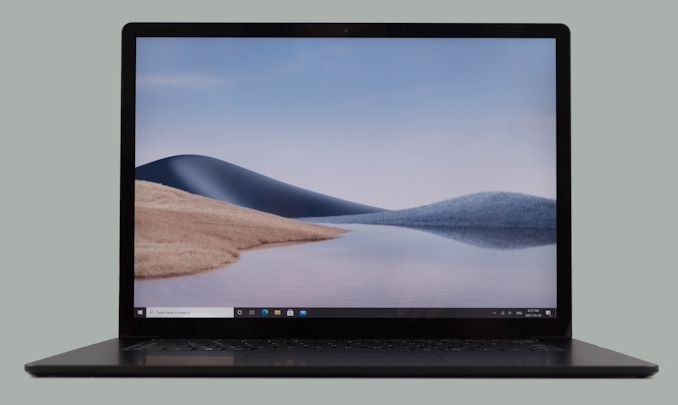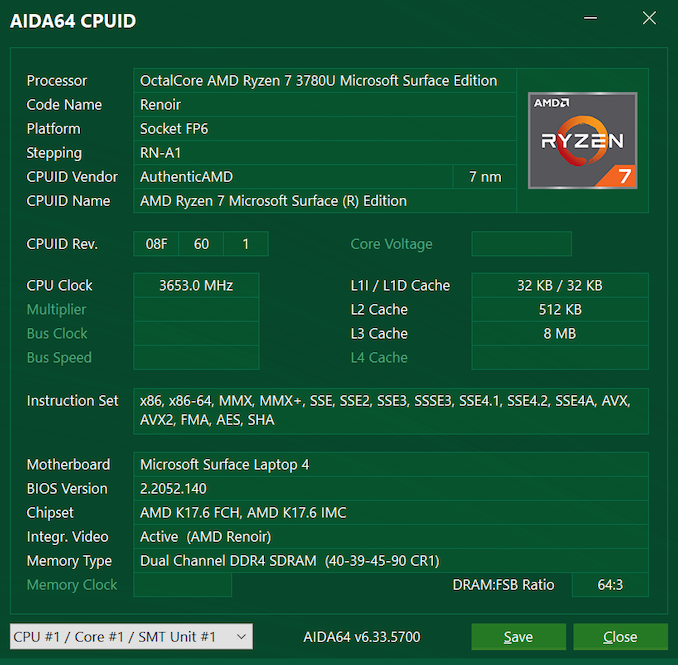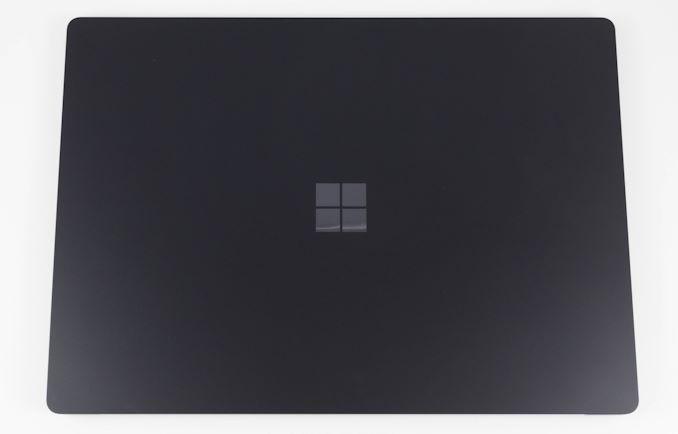The Microsoft Surface Laptop 4 15-Inch Review: Refreshing Ryzen
by Brett Howse on May 6, 2021 8:00 AM EST
Over the years, Microsoft’s Surface team has become quite a driver of innovation in the PC space. While the original Surface Pro was mostly just a curio, Microsoft continued to iterate through designs, and eventually found their breakthrough product with the very popular Surface Pro 3 convertible tablet. Since then, Microsoft has been able to further build off of the Surface brand's success with additional and interesting designs, including the Surface Book with its detachable display, the Surface Studio all-in-one, and the Surface Pro X which pushes the Surface Pro design into a new, more modern take on the convertible tablet.
But with a burgeoning brand, Microsoft has also developed some more conservative devices under the Surface family, and this is most evident with Microsoft's Surface Laptop lineup. The Surface Laptop, now in its fourth generation, has never felt like it was as innovative as the other designs, but the most conventional member of the Surface family does something that no other Surface device can: cater to a wider market looking for a more traditional laptop design. As a result, the Surface Laptop has become a quiet workhorse of sorts for the Surface family, filling the need for a traditional clamshell laptop while still finding just enough space to put the Surface flourish on the complete package.
Today, we are looking at the latest generation Surface Laptop 4 to see how the changes under the hood impact the experience of Microsoft’s thin and light clamshell laptop design.
Compared to other popular laptop lineups, the major points of differentiation with the original Surface Laptop were the inclusion of an Alcantara keyboard deck, and a 3:2 aspect ratio display. While neither of those choices were revolutionary, Microsoft’s decisions have, in fact, moved the industry forward. We are seeing many more devices being offered with taller displays, either 3:2 or 16:10, and although the Alcantara keyboard deck has not been replicated by other manufacturers, devices like the all-leather HP Spectre Folio is certainly another device attempting to try a material other than metal to provide a premium laptop feel. And of course, Microsoft hasn't stopped there, and has continued iterating on the Surface Laptop family through now what is several generations.
That brings us to the latest edition of the Surface Laptop, the aptly named Surface Laptop 4. Following their previous decision with the Surface Laptop 3 to source CPUs from both Intel and AMD for their laptops, Microsoft has opted to do the same once more. So depending on which version a given laptop is, it might contain either an AMD Ryzen 4000 "Renoir" APU or an Intel "Tiger Lake" 11th gen Core CPU. This kind of diversification means that the two laptop lines are quite different at times – Intel tops out at half as many CPU cores as AMD, for example – but for Microsoft it gives them a lot of options for performance and pricing, and of course it doesn't leave them beholden to any one CPU vendor.
| Microsoft Surface Laptop 4 Model Tested: 15-inch Ryzen 7 4980U / 16 GB / 512 GB |
|||||||
| 13.5-Inch | 15-Inch | ||||||
| Processor | Intel Core i5-1145G7 Intel Core i7-1185G7 AMD Ryzen 5 4680U |
Intel Core i7-1185G7 AMD Ryzen 7 4980U |
|||||
| Memory | 8GB/16GB/32GB LPDDR4X-3733MHz | ||||||
| Graphics | Intel: Intel Iris Xe Graphics AMD: AMD Ryzen Microsoft Surface Edition Radeon Graphics |
||||||
| Display | 13.5" 2256x1504 3:2 PixelSense Touch and Pen support Individually calibrated panels |
15" 2496x1664 3:2 PixelSense Touch and Pen support Individually calibrated panels |
|||||
| Storage | 256 GB, 512 GB, 1 TB PCIe NVMe Removable M.2 Drive |
||||||
| Networking | Wi-Fi 6 802.11ax - Intel AX200 Series Bluetooth 5.0 |
||||||
| Audio | Omnisonic Speakers Dolby Atmos |
||||||
| Battery | 46 Wh 65 Watt AC Adapter with USB-A Charge Port |
||||||
| Right Side | Surface Connect Port | ||||||
| Left Side | USB Type-A USB Type-C Headset Jack |
||||||
| Dimensions | 308 x 223 x 14.51 mm (12.1 x 8.8 x 0.57 inches) | 339.5 x 244 x 14.69 mm (13.4 x 9.6 x 0.57 inches) | |||||
| Weight | Fabric: 1.26kg Metal: 1.29kg |
1.54kg | |||||
| Camera | Front: 720p Camera and Windows Hello support Dual far-field Studio Mics |
||||||
| Extras | Surface Pen and Dial (sold separately) TPM 2.0 |
||||||
| Pricing | Starting at $999 USD | Starting at $1099 USD | |||||
For today's review, Microsoft has sent over the AMD-powered version of the 15-inch Surface Laptop 4. Compared to last year's AMD-powered 15-inch Surface Laptop 3, it's a big step up in a few regards. The switch to Ryzen 4000 mobile APUs brings with it some significant power savings, not to mention a potentially sizable performance boost thanks to the Zen 2 CPU architecture and doubling the total CPU core count from 4 to 8. Even annoying little discrepancies, such as the AMD model only shipping Wi-Fi 5 have been taken care of this time around, and now all models ship with Wi-Fi 6.
And although the Surface Laptop 4 refresh is only a refresh of the internals, that is the one area where the Surface Laptop 3 needed the most help, and the Surface Laptop 4 includes most of what you would expect in a new device for 2021. Storage is all user-replaceable now, with up to 1 TB M.2, whereas Surface leveraged soldered BGA storage for several of the last generations. Memory is up to 32 GB, although strangely only on the Intel-powered devices. Microsoft continues to include a USB Type-A port, along with a USB Type-C, and the Surface Connect port. The Surface team continues to avoid Thunderbolt 4, for reasons that make little sense, but at least they have started to include the Type-C port.

The semi-custom Ryzen 7 4980U which reports itself as a 3780U
Otherwise, like last year's models, the choice of Intel or AMD still comes with some interesting tradeoffs. For the 15-inch laptops, the Ryzen 7 SKUs are the de facto budget option once again, with our $1699 review laptop coming in at $100 cheaper than the equivalent Intel option. This is despite the 8 vs. 4 CPU core advantage, which means the "budget" AMD option packs a lot more CPU processing power, at least on paper. Though the entire matter is somewhat moot at this second, since Microsoft is completely sold out of 15-inch Intel models.
The Intel models do have something else going for them, however, and that's the sheer age of the platform. Tiger Lake is essentially a generation newer than Renoir, despite the fact that both are going into the latest Surface Laptop. So this means that they not only ship with Intel's latest Willow Cove CPU architecture, but the latest-generation Xe-LP graphics as well. And though the benefits of these vary with the workload, it definitely keeps Intel more competitive than an otherwise high-level look at the specs would tell you.
Microsoft, more than any other device manufacturer, tends to update products on their own schedule, rather than trying to synchronize with the annual processor updates from both Intel and AMD. And while this offers some advantages, it also means that the long-delay between updates can render a good product difficult to recommend for a large part of its shelf life. This is something that hampered the Surface Laptop 3 – where Microsoft launched the Ryzen 3000 "Picasso" based device mere months before AMD launched their long-awaited next-generation “Renoir” APUs. And thus the AMD-powered Surface Laptop 3 quickly found itself rendered uncompetitive with newer AMD laptops.
This is risk that, unfortunately, is even more present for the Surface Pro 4. Microsoft is just now shipping Ryzen 4000, all the while AMD has already shipped products with the new 5th generation "Cezanne" APU, featuring the latest Zen 3 cores. So like the Surface Laptop 3 before it, the Surface Laptop 4 is starting its life with some questionable choices on the AMD front.
The good news, at least, for Surface fans looking for an AMD powered notebook is that none of this takes away from what the now last-generation Renoir can do. AMD’s Renoir platform was the star of 2020, fixing the power draw issues of Picasso, as well as making the previously-mentioned core count increase. AMD’s Vega GPU is also quite strong – enough so that AMD has chosen to continue using it with Cezanne. So, while it is disappointing to see a newly launched laptop in 2021 feature the last-generation AMD processor, the AMD Ryzen 4000 is still a strong choice, especially as the step between Ryzen 4000 and Ryzen 5000 is a relatively small one.











98 Comments
View All Comments
Speednet - Thursday, May 6, 2021 - link
Great writeup, but would have been awesome to see SL4 Intel vs. AMD.desii - Thursday, May 6, 2021 - link
No, I don't think a single USB A port is "enough for most people".cknobman - Thursday, May 6, 2021 - link
Writer mentions this is no workstation.Please tell me why "most people" need more than one legacy USB A port.
dullard - Thursday, May 6, 2021 - link
think touchpads suck. So, I always need a mouse. Virtually all mice are USB-A. That means if I want to use anything else whatsover with USB-A, I now need expensive adapters, docks, etc. No thumb drives, no external optical drives, no external storage drives, no printers, no wireless keyboards, etc.While I don't have any evidence to say "most" people need two, there are plenty of use cases where someone wants a mouse + one other device.
mrochester - Thursday, May 6, 2021 - link
Bluetooth mice exist.TheinsanegamerN - Thursday, May 6, 2021 - link
Most of which ship with a USB A adapter they are already paired to, and which most people will use.Eletriarnation - Thursday, May 6, 2021 - link
Microsoft will probably be OK if they write off the folks who need a bunch of Type-A ports and haven't figured out that hubs and Bluetooth exist.meacupla - Thursday, May 6, 2021 - link
I don't think you understand what a "Bluetooth" mouse ismrochester - Saturday, May 8, 2021 - link
Bluetooth mice don't need USB adaptors, that's the point.zmatt - Tuesday, May 11, 2021 - link
Most cheap ones cant arbitrarily pair to a bluetooth capable PC. They come pre-paired to a usb dongle and thats it. Either plug it in or you don't use it.